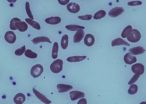(Press-News.org) Use of a lower intensity bone marrow transplantation method showed promising results among 30 patients (16-65 years of age) with severe sickle cell disease, according to a study in the July 2 issue of JAMA.
Myeloablative (use of high-dose chemotherapy or radiation) allogeneic hematopoietic stem cell transplantation (HSCT; receipt of hematopoietic stem cells "bone marrow" from another individual) is curative for children with severe sickle cell disease, but associated toxicity has made the procedure prohibitive for adults. The development of nonmyeloablative conditioning regimens (use of lower doses of chemotherapy or radiation to prepare the bone marrow to receive new cells) may facilitate safer application of allogeneic HSCT to eligible adults, according to background information in the article.
Matthew M. Hsieh, M.D., of the National Institute of Diabetes and Digestive and Kidney Diseases, Bethesda, Md., and colleagues explored a nonmyeloablative approach in a pilot group of 10 adults with severe sickle cell disease, using a simplified HSCT regimen (with stem cell donation from a immunologically matched sibling), that had few toxic effects, yet all patients continued taking immunosuppression medication. The researchers have since revised the protocol to include an option to stop immunosuppression after 1 year in selected patients (those with donor CD3 engraftment of greater than 50 percent and normalization of hemoglobin). In this report, the authors describe the outcomes for 20 additional patients with severe sickle cell disease, along with updated results from the first 10 patients. All 30 patients (ages 16-65 years) were enrolled in the study from July 2004 to October 2013.
As of October 25, 2013, 29 patients were alive with a median follow-up of 3.4 years, and 26 patients (87 percent) had long-term stable donor engraftment without acute or chronic graft-vs-host disease. Hemoglobin levels improved after HSCT; at 1 year, 25 patients (83 percent) had full donor-type hemoglobin. Fifteen engrafted patients discontinued immunosuppression medication and had no graft-vs-host disease.
The average annual hospitalization rate was 3.2 the year before HSCT, 0.63 the first year after, 0.19 the second year after, and 0.11 the third year after transplant. Eleven patients were taking narcotics long-term at the time of transplant. During the week they were hospitalized and received their HSCT, the average narcotics use per week was 639 mg of intravenous morphine-equivalent dose. The dosage decreased to 140 mg 6 months after the transplant.
There were 38 serious adverse events including pain, infections, abdominal events, and toxic effects from the medication sirolimus.
"In this article, we extend our previous results and show that this HSCT procedure can be applied to older adults, even those with severe comorbid conditions …" the authors write. "These data reinforce the low toxicity of this regimen, especially among patients with significant end-organ dysfunction."
"In this series of patients who underwent a simplified HSCT regimen to date, … reversal of sickle cell disease phenotype was achieved in the majority of patients. Engrafted patients continued to be disease-free and without graft-vs-host disease," the researchers write. "Further accrual and follow-up is required to assess longer-term clinical outcomes, adverse events, and transplant tolerance."
INFORMATION:
(doi:10.1001/jama.2014.7192; Available pre-embargo to the media at http://media.jamanetwork.com)
Editor's Note: This work is supported by the intramural research program of the National Institute of Diabetes and Digestive and Kidney Diseases and the National Heart, Lung, and Blood Institute at the National Institutes of Health. All authors have completed and submitted the ICMJE Form for Disclosure of Potential Conflicts of Interest and none were reported.
There will also be a digital news release available for this study, including the JAMA Report video, embedded and downloadable video, audio files, text, documents, and related links. This content will be available at 3 p.m. CT Tuesday, July 1 at this link.
Editorial: Reconsideration of Age as a Contraindication for Curative Therapy of Sickle Cell Disease
Allison A. King, M.D., M.P.H., and John F. DiPersio, M.D., Ph.D., of the Washington University School of Medicine, St. Louis, comment on the findings of this study in an accompanying editorial.
"In a population of relatively older adults with sickle cell disease, these findings offer hope. Based on these exciting results, the role of age as a contraindication for offering adults with sickle cell disease and a matched sibling the chance of curative allogeneic stem cell transplant should be reconsidered."
(doi:10.1001/jama.2014.7193; Available pre-embargo to the media at http://media.jamanetwork.com)
Editor's Note: The authors have completed and submitted the ICMJE Form for Disclosure of Potential Conflicts of Interest and none were reported.
Bone marrow transplantation shows potential for treating adults with sickle cell disease
2014-07-01
ELSE PRESS RELEASES FROM THIS DATE:
Drug everolimus does not improve overall survival in patients with advanced liver cancer
2014-07-01
Despite strong preclinical data, the drug everolimus failed to improve overall survival in patients with advanced liver cancer, compared to placebo, according to a study in the July 2 issue of JAMA.
Patients with advanced hepatocellular carcinoma (HCC; a type of liver cancer) have a median overall survival of less than l year, largely because of the absence of effective therapies. The drug sorafenib is the only systemic therapy shown to significantly improve overall survival in advanced HCC; however its benefits are mostly transient and modest, and disease eventually ...
Study examines neurological outcomes for TBI treatments
2014-07-01
In patients with a traumatic brain injury (TBI), neither the administration of the hormone erythropoietin (EPO) or maintaining a higher hemoglobin concentration through blood transfusion resulted in improved neurological outcome at 6 months, according to a study in the July 2 issue of JAMA. Transfusing at higher hemoglobin concentrations was associated with a higher risk of adverse events.
Patients with severe traumatic brain injury commonly develop anemia. For patients with neurological injury, anemia is a potential cause of secondary injury, which may worsen neurological ...
Whole-exome sequencing helpful to id gene mutations linked to nervous system diseases
2014-07-01
Use of exome sequencing improved the ability to identify the underlying gene mutations in patients with biochemically defined defects affecting multiple mitochondrial respiratory chain complexes (enzymes that are involved in basic energy production), according to a study in the July 2 issue of JAMA.
Defects of the mitochondrial respiratory chain have emerged as the most common cause of childhood and adult neurometabolic disease, with an estimated prevalence of l in 5,000 live births. Clinically these disorders can present at any time of life, are often seen in association ...
Medicare-backed breast cancer screenings skyrocket, but do patients benefit?
2014-07-01
Breast cancer screening costs for Medicare patients skyrocketed between 2001 and 2009, but the increase did not lead to earlier detection of new breast cancer cases, according to a study published by Yale School of Medicine researchers in the July 1 Journal of the National Cancer Institute.
While the number of screening mammograms performed among Medicare patients remained stable during the same time period, the study focused on the adoption of newer imaging technologies in the Medicare population, such as digital mammography. Brigid Killelea, M.D., assistant professor ...
Adults stop anti-rejection drugs after stem-cell transplant reverses sickle cell disease
2014-07-01
Adults stop anti-rejection drugs after stem-cell transplant reverses sickle cell disease
NIH trial success suggests a new treatment option for older, sicker patients
Half of patients in a trial have safely stopped immunosuppressant medication following a modified blood stem-cell transplant for severe sickle cell disease, according to a study in the July 1 issue of the Journal of the American Medical Association. The trial was conducted at the National Institutes of Health's Clinical Center in Bethesda, Maryland, by researchers from NIH's National Institute of Diabetes ...
Seeing your true colors: Standards for hyperspectral imaging
2014-07-01
Today, doctors who really want to see if a wound is healing have to do a biopsy or some other invasive technique that, besides injuring an already injured patient, can really only offer information about a small area. But a technology called hyperspectral imaging offers doctors a noninvasive, painless way to discriminate between healthy and diseased tissue and reveal how well damaged tissue is healing over a wide area. The catch? A lack of calibration standards is impeding its use.
After a successful non-human trial, researchers at the National Institute of Standards ...
New NIST metamaterial gives light a one-way ticket
2014-07-01
The light-warping structures known as metamaterials have a new trick in their ever-expanding repertoire. Researchers at the National Institute of Standards and Technology (NIST) have built a silver, glass and chromium nanostructure that can all but stop visible light cold in one direction while giving it a pass in the other.* The device could someday play a role in optical information processing and in novel biosensing devices.
In recent years, scientists have designed nanostructured materials that allow microwave or infrared light to propagate in only one direction. ...
Fear, not data, motivates sunscreen users, research shows
2014-07-01
BUFFALO, N.Y. – We're often told that worrying can be harmful to one's health. But University at Buffalo researchers say that when it comes to preventing skin cancer, a little fear is good for you.
In a study published in the Journal of Behavioral Medicine, the UB researchers found that fear and worry about skin cancer had a bigger influence on people's use of sunscreen than information about the statistical likelihood of developing the disease.
"Most health behavior studies don't account for the more visceral, emotional reactions that lead people to do risky behaviors, ...
NIST test house exceeds goal; ends year with energy to spare
2014-07-01
The net-zero energy test house at the National Institute of Standards and Technology (NIST) in suburban Washington, D.C., not only absorbed winter's best shot, it came out on top, reaching its one-year anniversary on July 1 with enough surplus energy to power an electric car for about 1,440 miles.*
Watch the YouTube video at https://www.youtube.com/watch?v=iJZrOhPk4kg
Despite five months of below-average temperatures and twice the normal amount of snowfall, NIST's Net-Zero Energy Residential Test Facility (NZERTF) ended its one-year test run with 491 kilowatt hours ...
Biomarker predicts effectiveness of brain cancer treatment
2014-07-01
Researchers at the University of California, San Diego School of Medicine have identified a new biomarker that predicts whether glioblastoma – the most common form of primary brain cancer – will respond to chemotherapy. The findings are published in the July print issue of Oncotarget.
"Every patient diagnosed with glioblastoma is treated with a chemotherapy called temozolomide. About 15 percent of these patients derive long-lasting benefit," said Clark C. Chen, MD, PhD, vice-chairman of Academic Affairs, Division of Neurosurgery, UC San Diego School of Medicine and the ...




